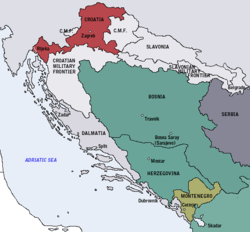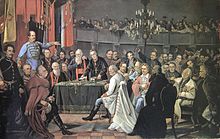- Kingdom of Croatia (Habsburg)
-
Kingdom of Croatia
Kraljevina Hrvatska
Regnum Croatiae
Königreich KroatienLand of the Crown of St. Stephen within the Habsburg Monarchy (1527-1804)
then Constituent land of the Austrian Empire← 
1527–1868  →
→

Flag Coat of arms Map of the Kingdom of Croatia (red) in late 1867 and early 1868, before the Nagodba. Other lands of the Austrian Empire are in white (and light grey). Capital Zagreb
(Varaždin 1756−1776)Language(s) Latin
German(unofficial)
Croatian (unofficial)Religion Roman Catholic Government Monarchy Historical era Early Modern period - Joined the Habsburg Monarchy alongside the Kingdom of Hungary 1527 - Joined with the Kingdom of Slavonia into the Kingdom of Croatia-Slavonia 1868 Currency gulden The Kingdom of Croatia (Croatian: Kraljevina Hrvatska; Latin: Regnum Croatiae German: Königreich Kroatien) was an administrative division that existed between 1527 and 1868 within the Habsburg Monarchy (also known between 1804 and 1867 as the Austrian Empire). The Kingdom was a part of the Lands of the Crown of St. Stephen, but was subject to direct Imperial Austrian rule for significant periods of time, including its final years. Its capital was Zagreb.
Until the 18th century, the Habsburg Kingdom of Croatia included only a small north-western part of present-day Croatia around Zagreb, and a small strip of coastland around Rijeka that was not part of the Ottoman Empire or part of the Habsburg Military Frontier. Between 1744 and 1868 the Kingdom of Croatia included a subordinate autonomous kingdom, the Kingdom of Slavonia. The territory of the Slavonian Kingdom was recovered from the Ottoman Empire, and was subsequently part of the Habsburg Military Frontier for a period. In 1744 these territories were organized as the Kingdom of Slavonia and included within the Kingdom of Croatia as an autonomous part. In 1849, the two kingdoms were completely separated and existed as two separate administrative units. In 1868 both were merged again into the newly formed Kingdom of Croatia-Slavonia.
Contents
History
Habsburg rule
Following the Battle of Mohács, in 1527 the Croatian and Hungarian nobles needed to decide on a new king. The bulk of the Croatian nobility convened the Croatian Parliament on Cetin and chose the suzerainty to the Austrian king Ferdinand I of Habsburg.[1][2] Some of the nobles dissented and supported János Szapolyai, but the Habsburg option prevailed by 1540, when Szapolyai died.
Territory retaken from the Ottoman Empire was formed in 1745 as the Kingdom of Slavonia, subordinate to the Croatian Kingdom. In 1804 the Habsburg Monarchy became the Austrian Empire which annexed the Venetian Republic in 1814 and established the Kingdom of Dalmatia. After the Austro-Hungarian Compromise of 1867 (by which the Austrian Empire became the Austro-Hungarian Empire) and the Croatian-Hungarian Nagodba of 1868, the Kingdom of Croatia and Kingdom of Slavonia were joined into the Kingdom of Croatia-Slavonia within the Lands of the Crown of St. Stephen in the Hungarian part of the Empire, while the Kingdom of Dalmatia became a Kronland in the Austrian part of the Empire (Cisleithania). The new Kingdom claimed the Kingdom of Dalmatia, as the remaining Croatian land in the Empire, and often referred to itself as the "Triune Kingdom of Croatia, Slavonia, and Dalmatia".
Ottoman incursion
The change of leadership was far from a solution to the war with the Turks, in fact, the Ottoman Empire gradually expanded in the 16th century to include most of Slavonia, western Bosnia and Lika.
Taking advantage of the growing conflict between Maximilian and Sigismund, Suleyman started his sixth raid of Hungary in 1565 with 150,000 troops. They successfully progressed northwards until 1566 when they took a small detour to capture the outpost of Siget (Szigetvár) which they failed to capture ten years previously. The small fort was defended by Count Nikola Šubić Zrinski and 2500 men. They were able to hold their ground for a month, and decimated the Ottoman army before being wiped out themselves. This siege, now known as the Battle of Szigetvár,[3] bought enough time to allow Austrian troops to regroup before the Turks could reach Vienna.
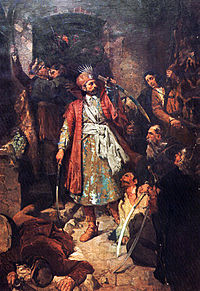 Nikola Šubić Zrinski by Oton Iveković. The work depicts Croatian Ban Nikola Šubić Zrinski defending against the Turks at the Battle of Szigetvár
Nikola Šubić Zrinski by Oton Iveković. The work depicts Croatian Ban Nikola Šubić Zrinski defending against the Turks at the Battle of Szigetvár
By orders of the king in 1553 and 1578, large areas of Croatia and Slavonia adjacent to the Ottoman Empire were carved out into the Military Frontier (Vojna Krajina) and ruled directly from Vienna's military headquarters. Due to the dangerous proximity to the Ottoman armies, the area became rather deserted, so Austria encouraged the settlement of Serbs, Germans, Hungarians, Czechs, Slovaks and Rusyns/Ukrainians and other Slavs in the Military Frontier, creating an ethnic patchwork.
The negative effects of feudalism escalated in 1573 when the peasants in northern Croatia and Slovenia rebelled against their feudal lords over various injustices such as unreasonable taxation or abuse of women in the Croatian and Slovenian peasant revolt. Ambroz Matija Gubec and other leaders of the mutiny raised peasants to arms in over sixty fiefs throughout the country in January 1573, but their uprising was crushed by early February. Matija Gubec and thousands of others were publicly executed shortly thereafter, in a rather brutal manner in order to set an example for others.
After the Bihać fort finally fell to the army of the Bosnian vizier Hasan-pasha Predojević in 1592, only small parts of Croatia remained unconquered. The remaining 16,800 km² were referred to as the remnants of the remnants of the once great Croatian kingdom[4]
17th and 18th centuries
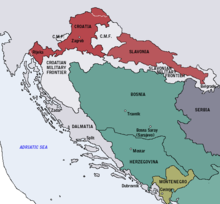 The Habsburg Kingdom of Croatia (red) at its largest territorial extent in late 1848. The Kingdom of Slavonia (light red) was at the time an autonomous subordinate kingdom within Croatia.
The Habsburg Kingdom of Croatia (red) at its largest territorial extent in late 1848. The Kingdom of Slavonia (light red) was at the time an autonomous subordinate kingdom within Croatia.
After the Battle of Sisak in 1593, when the Ottoman army was successfully repelled for the first time on the territory of Croatia, the lost territory was mostly restored, except for large parts of today's Bosnia and Herzegovina. By the 18th century, the Ottoman Empire was driven out of Ottoman Hungary and Croatia, and Austria brought the empire under central control.
The Austrian imperial army was victorious against the Turks in 1664 but Emperor Leopold failed to capitalize on the success when he signed the Peace of Vasvár in which Hungary and Croatia were prevented from regaining territory lost to the Ottoman Empire. This caused unrest among the Hungarian and Croatian nobility which plotted against the emperor, but they weren't powerful enough to actually do something about it, even though they negotiated with both the French and the Turks. Imperial spies uncovered the conspiracy and on April 30, 1671 executed four esteemed Croatian and Hungarian noblemen involved in it, Petar Zrinski, F. K. Frankopan, F. Nádasdy and E. Tatenbach, in Wiener Neustadt.
Croatia was one of the crown lands that supported Emperor Charles's Pragmatic Sanction of 1713[2] and supported Empress Maria Theresia in the War of Austrian Succession of 1741-1748. Subsequently, the empress made significant contributions to Croatian matters, by making several changes in the administrative control of the Military Frontier, the feudal and tax system. She also gave the independent port of Rijeka to Croatia in 1776. However, she also ignored and eventually disbanded the Croatian Parliament and in 1779, Croatia was relegated to just one seat in the governing council of Hungary, held by the ban of Croatia.
With the fall of the Venetian Republic in 1797, its possessions in eastern Adriatic mostly came under the authority of France which passed its rights to Austria the same year. Eight years later they were restored to France as the Illyrian provinces, but won back to the Austrian crown by 1815. Though now part of the same empire, Dalmatia and Istria were part of Cisleithania while Croatia and Slavonia were under Hungary.
19th century
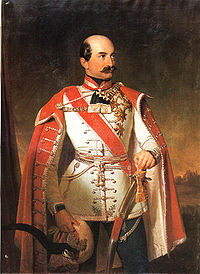 Field Marshal Josip Jelačić, Ban of the Kingdom of Croatia-Slavonia and Commander of the Croatian Military Frontier.
Field Marshal Josip Jelačić, Ban of the Kingdom of Croatia-Slavonia and Commander of the Croatian Military Frontier.
In the 19th century Croatian romantic nationalism emerged to counteract the non-violent but apparent Germanization and Magyarization. The Croatian national revival began in the 1830s with the Illyrian movement. The movement attracted a number of influential figures and produced some important advances in the Croatian language and culture. The champion of the Illyrian movement was Ljudevit Gaj who also reformed and standardized the Croatian literary language. Official language in Croatia has been Latin until 1847 when it has become Croatian.[2]
By the 1840s, the movement had moved from cultural goals to resisting Hungarian political demands. By the royal order of January 11, 1843, originating from the chancellor Metternich, the use of the Illyrian name and insignia in public was forbidden. This deterred the movement's progress but it couldn't stop the changes in the society that had already started.
In the Revolutions of 1848 in Habsburg areas, the Croatian Ban Jelačić cooperated with the Austrians in quenching the Hungarian Revolution of 1848 by leading a military campaign into Hungary, successful until the Battle of Pakozd. Despite this contribution, Croatia was later subject to Baron Alexander von Bach's absolutism as well as the Hungarian hegemony under ban Levin Rauch when the Empire was transformed into a dual monarchy of Austria-Hungary in 1867.
Nevertheless, Ban Jelačić had succeeded in the abolition of serfdom in Croatia, which eventually brought about massive changes in society: the power of the major landowners was reduced and arable land became increasingly subdivided, to the extent of risking famine. Many Croatians started emigrating to the New World countries in this period, a trend that would continue throughout the next hundred years and create a large Croatian diaspora.
The Illyrian movement was rather broad in scope, both nationalist and pan-Slavist. It would eventually develop into two major causes:
- a Croatian national cause aimed primarily at the unification and independence of the people of Croatia, headed by people like the parliamentarian Ante Starčević, who formed the Party of Rights in 1861
- a pan-South-Slavic, Yugoslav cause also oriented towards the integration of the neighboring South Slavic nations, organized through the People's Party, and headed by people like bishop Josip Juraj Strossmayer, who founded the Yugoslav Academy of Sciences and Arts in 1867 and re-founded the University of Zagreb in 1874
History of Croatia 
This article is part of a seriesEarly history Prehistoric Croatia Origins of the Croats White Croatia Medieval history Littoral Croatia · Pannonian Croatia · Pagania · Zachlumia · Travunia Kingdom of Croatia March of Istria Republic of Poljica Republic of Dubrovnik Kingdom of Bosnia Habsburg Empire Kingdom of Croatia Croatian Military Frontier Illyrian Provinces · Kingdom of Illyria Kingdom of Slavonia Kingdom of Dalmatia Kingdom of Croatia-Slavonia State of Slovenes, Croats, and Serbs Yugoslavia Kingdom of Yugoslavia
(Banovina of Croatia)World War II
Independent State of Croatia
Federal State of CroatiaSocialist Republic of Croatia Contemporary Croatia War of independence Republic of Croatia
Croatia Portal
The loss of Croatian domestic autonomy was rectified a year after the Austro-Hungarian Compromise of 1867, when in 1868 the Hungarian-Croatian Settlement was negotiated. However, the governor (ban) was appointed by Hungary, 55% percent of all tax money went to Budapest, and Hungary had authority over the biggest sea port of Rijeka (something that was reportedly not part of the Settlement actually agreed upon). With this agreement, the Kingdom of Croatia received autonomy in administrative, educational, and judicial affairs.[4]
Demographics
In 1840, an Austrian population census was conducted in the crownland of Croatia (which included Slavonia). There were 1,605,730 people, of which:[5]
Insignia
In 1848 the Kingdom of Croatia adopted a new official flag and coat of arms. The new flag was the Croatian tricolor of red, white, and blue, and it was to remain the symbol of Croatia up to the present day. The coat of arms adopted in 1848 was an amalgam of three coats of arms, one for Croatia, another for the Kingdom of Dalmatia, and another for the Kingdom of Slavonia. The Kingdom also used the name "Triune Kingdom of Croatia, Slavonia, and Dalmatia" during certain periods (though this was not recognized by the Empire). The Kingdom still controlled the Kingdom of Slavonia, but did not control the Kingdom of Dalmatia. In 1849 the Kingdom of Slavonia was made independent of the Kingdom of Croatia, and in 1852 the imperial Austrian government, which never recognized the tricolor as official, banned its use, along with the coat of arms. Between 1852 and 1868 the Kingdom of Croatia used the red and white flag, and its old chequy coat of arms.
See also
- Kingdom of Croatia-Slavonia
- Kingdom of Croatia (Medieval)
- Kingdom of Slavonia
- Kingdom of Dalmatia
- History of Croatia
- Bans of Croatia
- Kings of Croatia
References
- ^ Milan Kruhek: Cetin, grad izbornog sabora Kraljevine Hrvatske 1527, Karlovačka Županija, 1997, Karlovac
- ^ a b c History of Croatian parliament (Croatian)
- ^ Dupuy, R. Ernest and Dupuy, Trevor. The Encyclopedia of Military History. New York: Harper & Row, 1970. ISBN 0-06-011139-9
- ^ a b Catholic Encyclopedia
- ^ Dr Tomislav Bogavac, Nestajanje Srba, Niš, 1994, page 198.
External links
Categories:- Former monarchies of Europe
- Former countries in Europe
- States and territories established in 1527
- States and territories disestablished in 1868
- History of Croatia
- Former countries in the Balkans
- Former Slavic countries
Wikimedia Foundation. 2010.

